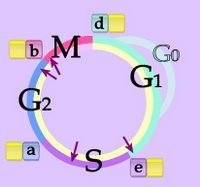cyclin-dependent kinases
Cyclin-dependent kinases (CDKs) play a role in regulation of transcription and in mRNA processing, and in regulation of the cell cycle. Specific protein kinases transfer a phosphate group from a donor such as ATP to amino acid acceptors in proteins, while protein phosphatases remove the phosphate groups that have been attached by protein kinases.
The activity of cyclin-dependent kinases is modulated by binding to cyclins, which are proteins so-named because their levels vary periodically during the cell cycle. The binding of cyclins to cyclin-dependent kinases regulates CDK activity, selecting the proteins to be phosphorylated. Although levels of CDK-molecules are constant during the cell cycle, their activities vary because of the regulatory function of the cyclins. Thus, periodic protein degradation is an important general control mechanism of the cell cycle.
 Right - Cell Cycle - click to enlarge image. Phases G1 and G0, S, G2, M. Checkpoints - purple arrows at G1-S transition, during S phase, G2-M transition, anaphase of mitosis. CDKs (yellow) are modulated by association with a series of fluctuating cyclins (d, e, a, b.) The cycle is divided into non-mitotic interphase (beige) with G1 or G0, S, and G2 phases followed by mitosis (pink).
Right - Cell Cycle - click to enlarge image. Phases G1 and G0, S, G2, M. Checkpoints - purple arrows at G1-S transition, during S phase, G2-M transition, anaphase of mitosis. CDKs (yellow) are modulated by association with a series of fluctuating cyclins (d, e, a, b.) The cycle is divided into non-mitotic interphase (beige) with G1 or G0, S, and G2 phases followed by mitosis (pink).
Cyclins were conserved during evolution. Around ten different cyclins have been found in humans. CDK and cyclin together drive the cell from one cell cycle phase to the next. Levels of cyclins D (G1), E and A (S), and B and A (mitotis, M) fluctuate during the cell cycle (d,e,a,b) , and binding of appropriate cyclins to the cyclin-dependent kinases (CDKs) stimulating phosphorylation and activation.
CDKs are an example of enzymes that possess separate phosphorylation sites for the activation or inhibition of functional regulation. CDKs are a subclass of serine/threonine protein kinases that can be either activated or deactivated depending upon the specific amino acid residue that is undergoing phosphorylation.
Studies with yeast and embryonic cells suggest that mitosis is triggered by the periodic activation of cdc2 kinase (cdk1), named for its role as a CDC-gene (cell division cycle gene). This member of the Ser/Thr protein kinase family is a catalytic subunit of the highly conserved protein kinase complex known as M-phase promoting factor (MPF), which is essential for G1/S and G2/M phase transitions of eukaryotic cell cycle. Mitotic cyclins form stable associations with cdk1 (cdc2), and function as regulatory subunits. Because the kinase activity of cdk1 is controlled by cyclin accumulation and destruction duringthe cell cycle, phosphorylation and dephosphorylation of cdk1 play important regulatory roles in cell cycle control. More than one hundred cell division cycle genes (CDC genes) are specifically involved in cell cycle control
▲ Top ▲

The activity of cyclin-dependent kinases is modulated by binding to cyclins, which are proteins so-named because their levels vary periodically during the cell cycle. The binding of cyclins to cyclin-dependent kinases regulates CDK activity, selecting the proteins to be phosphorylated. Although levels of CDK-molecules are constant during the cell cycle, their activities vary because of the regulatory function of the cyclins. Thus, periodic protein degradation is an important general control mechanism of the cell cycle.
 Right - Cell Cycle - click to enlarge image. Phases G1 and G0, S, G2, M. Checkpoints - purple arrows at G1-S transition, during S phase, G2-M transition, anaphase of mitosis. CDKs (yellow) are modulated by association with a series of fluctuating cyclins (d, e, a, b.) The cycle is divided into non-mitotic interphase (beige) with G1 or G0, S, and G2 phases followed by mitosis (pink).
Right - Cell Cycle - click to enlarge image. Phases G1 and G0, S, G2, M. Checkpoints - purple arrows at G1-S transition, during S phase, G2-M transition, anaphase of mitosis. CDKs (yellow) are modulated by association with a series of fluctuating cyclins (d, e, a, b.) The cycle is divided into non-mitotic interphase (beige) with G1 or G0, S, and G2 phases followed by mitosis (pink).Cyclins were conserved during evolution. Around ten different cyclins have been found in humans. CDK and cyclin together drive the cell from one cell cycle phase to the next. Levels of cyclins D (G1), E and A (S), and B and A (mitotis, M) fluctuate during the cell cycle (d,e,a,b) , and binding of appropriate cyclins to the cyclin-dependent kinases (CDKs) stimulating phosphorylation and activation.
CDKs are an example of enzymes that possess separate phosphorylation sites for the activation or inhibition of functional regulation. CDKs are a subclass of serine/threonine protein kinases that can be either activated or deactivated depending upon the specific amino acid residue that is undergoing phosphorylation.
Studies with yeast and embryonic cells suggest that mitosis is triggered by the periodic activation of cdc2 kinase (cdk1), named for its role as a CDC-gene (cell division cycle gene). This member of the Ser/Thr protein kinase family is a catalytic subunit of the highly conserved protein kinase complex known as M-phase promoting factor (MPF), which is essential for G1/S and G2/M phase transitions of eukaryotic cell cycle. Mitotic cyclins form stable associations with cdk1 (cdc2), and function as regulatory subunits. Because the kinase activity of cdk1 is controlled by cyclin accumulation and destruction duringthe cell cycle, phosphorylation and dephosphorylation of cdk1 play important regulatory roles in cell cycle control. More than one hundred cell division cycle genes (CDC genes) are specifically involved in cell cycle control
▲ Top ▲








































